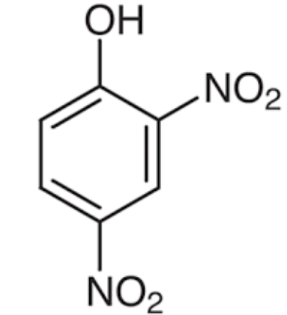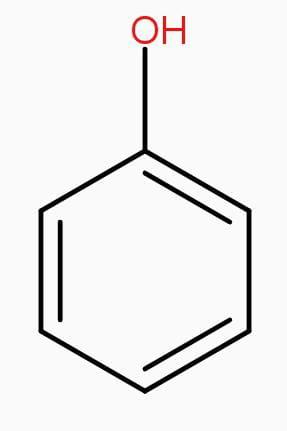Answer
396.3k+ views
Hint: To solve this question you should have a basic idea regarding the structures of phenol and 2,4-dinitrophenol and about electron withdrawing groups and its effect after adding to any compound. Phenol has a benzene ring with one hydroxyl group and 2,4-dinitrophenol has two nitrogen oxide molecules more than phenol.
Complete answer:
Structures of phenol and 2,4-dinitrophenol are drawn below.


(2,4 – dinitrophenol) (phenol)
In 2,4 – dinitrophenol two - $N{{O}_{2}}$ groups are present. $N{{O}_{2}}$ has a strong electron withdrawing nature which increases acidity of the compound.
Electron withdrawing group (EWG): An atom or group that draws electron density from neighboring atoms towards itself, usually by resonance or inductive effects.
Therefore, presence of two electron withdrawing - $N{{O}_{2}}$groups in the ring makes 2,4- dinitrophenol a stronger acid than phenol.
Sodium Carbonate solution is basic in nature. Hence, Stronger the acid it is easily soluble in the basic solution.
Therefore, it reacts with $N{{a}_{2}}C{{O}_{3}}$solution to form sodium salt with the evolution of $C{{O}_{2}}$, thus making it soluble in$N{{a}_{2}}C{{O}_{3}}$.
Hence, unlike phenol, 2,4-dinitrophenol is soluble in sodium carbonate solution in water because presence of two - $N{{O}_{2}}$groups in the ring makes 2, 4 – dinitrophenol a stronger acid than phenol.
Hence, option A is the right answer.
Note:
Always remember, 2,4,6 – trinitrophenol > 2,4 – dinitrophenol > phenol, order of acidic nature of the compounds.
Orders of electron withdrawing group is -$N{{O}_{2}}$, -$CN$,-$CHO$,-$COR$,-$COOH$,-$COOR$, -$CON{{H}_{2}}$(strongest to weakest)
Complete answer:
Structures of phenol and 2,4-dinitrophenol are drawn below.


(2,4 – dinitrophenol) (phenol)
In 2,4 – dinitrophenol two - $N{{O}_{2}}$ groups are present. $N{{O}_{2}}$ has a strong electron withdrawing nature which increases acidity of the compound.
Electron withdrawing group (EWG): An atom or group that draws electron density from neighboring atoms towards itself, usually by resonance or inductive effects.
Therefore, presence of two electron withdrawing - $N{{O}_{2}}$groups in the ring makes 2,4- dinitrophenol a stronger acid than phenol.
Sodium Carbonate solution is basic in nature. Hence, Stronger the acid it is easily soluble in the basic solution.
Therefore, it reacts with $N{{a}_{2}}C{{O}_{3}}$solution to form sodium salt with the evolution of $C{{O}_{2}}$, thus making it soluble in$N{{a}_{2}}C{{O}_{3}}$.
Hence, unlike phenol, 2,4-dinitrophenol is soluble in sodium carbonate solution in water because presence of two - $N{{O}_{2}}$groups in the ring makes 2, 4 – dinitrophenol a stronger acid than phenol.
Hence, option A is the right answer.
Note:
Always remember, 2,4,6 – trinitrophenol > 2,4 – dinitrophenol > phenol, order of acidic nature of the compounds.
Orders of electron withdrawing group is -$N{{O}_{2}}$, -$CN$,-$CHO$,-$COR$,-$COOH$,-$COOR$, -$CON{{H}_{2}}$(strongest to weakest)
Recently Updated Pages
Basicity of sulphurous acid and sulphuric acid are

Three beakers labelled as A B and C each containing 25 mL of water were taken A small amount of NaOH anhydrous CuSO4 and NaCl were added to the beakers A B and C respectively It was observed that there was an increase in the temperature of the solutions contained in beakers A and B whereas in case of beaker C the temperature of the solution falls Which one of the following statements isarecorrect i In beakers A and B exothermic process has occurred ii In beakers A and B endothermic process has occurred iii In beaker C exothermic process has occurred iv In beaker C endothermic process has occurred

What is the stopping potential when the metal with class 12 physics JEE_Main

The momentum of a photon is 2 times 10 16gm cmsec Its class 12 physics JEE_Main

How do you arrange NH4 + BF3 H2O C2H2 in increasing class 11 chemistry CBSE

Is H mCT and q mCT the same thing If so which is more class 11 chemistry CBSE

Trending doubts
Difference Between Plant Cell and Animal Cell

Difference between Prokaryotic cell and Eukaryotic class 11 biology CBSE

Fill the blanks with the suitable prepositions 1 The class 9 english CBSE

Change the following sentences into negative and interrogative class 10 english CBSE

Summary of the poem Where the Mind is Without Fear class 8 english CBSE

Give 10 examples for herbs , shrubs , climbers , creepers

Write an application to the principal requesting five class 10 english CBSE

What organs are located on the left side of your body class 11 biology CBSE

What is the z value for a 90 95 and 99 percent confidence class 11 maths CBSE



